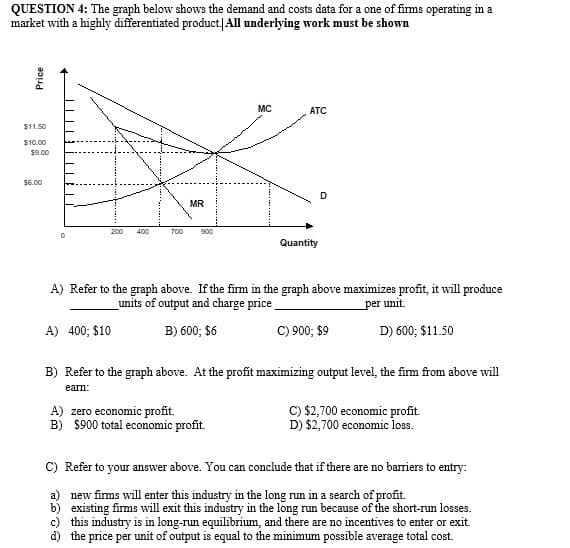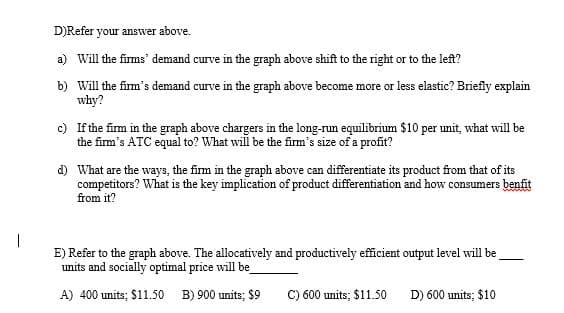QUESTION 4: The graph below shows the demand and costs data for a one of firms operating in a market with a highly differentiated product All underlying work must be shown MC ATC $11.50 $10.00 $9.00 $6.00 MR 200 400 700 900 Quantity A) Refer to the graph above. If the firm in the graph above maximizes profit, it will produce _units of output and charge price per unit. A) 400; $10 B) 600; $6 C) 900; $9 D) 600; $11.50 B) Refer to the graph above. At the profit maximizing output level, the firm from above will earn: A) zero economic profit. B) $900 total economic profit. C) $2,700 economic profit. D) $2,700 economic loss. C) Refer to your answer above. You can conclude that if there are no barriers to entry: new firms will enter this industry in the long run in a search of profit. b) existing fims will exit this industry in the long run because of the short-run losses. c) this industry is in long-run equilibrium, and there are no incentives to enter or exit. d) the price per unit of output is equal to the minimum possible average total cost. Price
QUESTION 4: The graph below shows the demand and costs data for a one of firms operating in a market with a highly differentiated product All underlying work must be shown MC ATC $11.50 $10.00 $9.00 $6.00 MR 200 400 700 900 Quantity A) Refer to the graph above. If the firm in the graph above maximizes profit, it will produce _units of output and charge price per unit. A) 400; $10 B) 600; $6 C) 900; $9 D) 600; $11.50 B) Refer to the graph above. At the profit maximizing output level, the firm from above will earn: A) zero economic profit. B) $900 total economic profit. C) $2,700 economic profit. D) $2,700 economic loss. C) Refer to your answer above. You can conclude that if there are no barriers to entry: new firms will enter this industry in the long run in a search of profit. b) existing fims will exit this industry in the long run because of the short-run losses. c) this industry is in long-run equilibrium, and there are no incentives to enter or exit. d) the price per unit of output is equal to the minimum possible average total cost. Price
Chapter7: Production And Cost In The Firm
Section: Chapter Questions
Problem 1.3P
Related questions
Question

Transcribed Image Text:QUESTION 4: The graph below shows the demand and costs data for a one of firms operating in a
market with a highly differentiated product/All underlying work must be shown
MC
ATC
$11.50
$10.00
$9.00
$6.00
D
MR
200
400
700
s00
Quantity
A) Refer to the graph above. If the firm in the graph above maximizes profit, it will produce
units of output and charge price
per unit.
A) 400; $10
B) 600; $6
C) 900; $9
D) 600; $11.50
B) Refer to the graph above. At the profit maximizing output level, the firm from above will
earn:
A) zero economic profit.
B) $900 total economic profit.
C) $2,700 economic profit.
D) $2,700 economic loss.
C) Refer to your answer above. You can conclude that if there are no barriers to entry:
a) new fims will enter this industry in the long run in a search of profit.
b) existing firms will exit this industry in the long run because of the short-run losses.
c) this industry is in long-run equilibrium, and there are no incentives to enter or exit.
d) the price per unit of output is equal to the minimum possible average total cost.
Price

Transcribed Image Text:D)Refer your answer above.
a) Will the firms' demand curve in the graph above shift to the right or to the left?
b) Will the fim's demand curve in the graph above become more or less elastic? Briefly explain
why?
c) If the firm in the graph above chargers in the long-nun equilibrium $10 per unit, what will be
the fim's ATC equal to? What will be the fim's size of a profit?
d) What are the ways, the firm in the graph above can differentiate its product from that of its
competitors? What is the key implication of product differentiation and how consumers benfit
from it?
E) Refer to the graph above. The allocatively and productively efficient output level will be
units and socially optimal price will be
A) 400 units; $11.50 B) 900 units; $9
C) 600 units; $11.50
D) 600 units; $10
Expert Solution
This question has been solved!
Explore an expertly crafted, step-by-step solution for a thorough understanding of key concepts.
This is a popular solution!
Trending now
This is a popular solution!
Step by step
Solved in 4 steps with 2 images

Knowledge Booster
Learn more about
Need a deep-dive on the concept behind this application? Look no further. Learn more about this topic, economics and related others by exploring similar questions and additional content below.Recommended textbooks for you


Managerial Economics: Applications, Strategies an…
Economics
ISBN:
9781305506381
Author:
James R. McGuigan, R. Charles Moyer, Frederick H.deB. Harris
Publisher:
Cengage Learning

Principles of Economics 2e
Economics
ISBN:
9781947172364
Author:
Steven A. Greenlaw; David Shapiro
Publisher:
OpenStax


Managerial Economics: Applications, Strategies an…
Economics
ISBN:
9781305506381
Author:
James R. McGuigan, R. Charles Moyer, Frederick H.deB. Harris
Publisher:
Cengage Learning

Principles of Economics 2e
Economics
ISBN:
9781947172364
Author:
Steven A. Greenlaw; David Shapiro
Publisher:
OpenStax